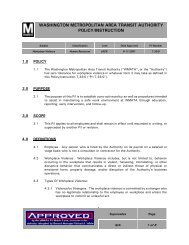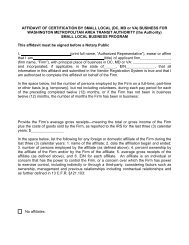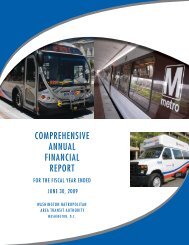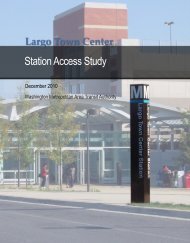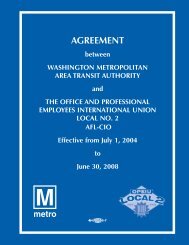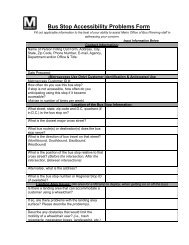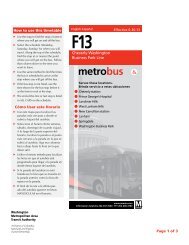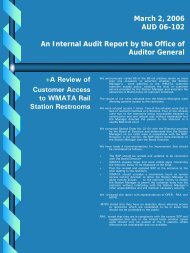Naylor Road Metro Station Area Access and Capacity - WMATA.com.
Naylor Road Metro Station Area Access and Capacity - WMATA.com.
Naylor Road Metro Station Area Access and Capacity - WMATA.com.
Create successful ePaper yourself
Turn your PDF publications into a flip-book with our unique Google optimized e-Paper software.
Appendix 8: Emergency Egress<br />
To meet NFPA 130 evacuation criteria, all passengers (i.e. station occupant load) on the station<br />
platform must clear the platform in four minutes <strong>and</strong> reach a point of safety in six minutes (note<br />
that the six-minute period includes the time to clear the platform). The station occupant load<br />
consists of the entraining load (i.e. all passengers entering the station to board a train) <strong>and</strong> the<br />
train load (i.e. passengers already on a train) during the peak period.<br />
The entraining load <strong>and</strong> the train load per platform are the sums of the entraining loads or train<br />
loads per track. A surge factor is applied to the entraining <strong>and</strong> the train loads in both directions,<br />
<strong>and</strong> a factor of two is applied to the peak direction to account for one missed headway, per<br />
NFPA 130 requirements. Thus, the station occupant load for <strong>Naylor</strong> <strong>Road</strong> <strong>Station</strong> in 2012 is:<br />
• 2012 AM Peak <strong>Station</strong> Occupant Load = [2 * surge * (NB entraining load + NB train load] +<br />
[surge * (SB entraining load + SB train load)]<br />
= [2 * 1.3 * (59 + 238)] + [1.3 * (9 + 37)] = 831<br />
• 2012 PM Peak <strong>Station</strong> Occupant Load = [2 * surge * (SB entraining load + SB train load)] +<br />
[surge * (NB entraining load + NB train load)]<br />
= [2 * 1.3 * (12 + 434)] + [1.3 * (1 + 50)] = 1,225<br />
Note: <strong>Naylor</strong> <strong>Road</strong> <strong>Station</strong> entraining <strong>and</strong> train loads for 2012 <strong>and</strong> 2040 are calculated in Tables A-18,<br />
A-20, A-22, <strong>and</strong> A-24. Values in this example are rounded.<br />
In the high level planning analysis used for this study, passengers disperse according to the<br />
available capacity of the exit points. One escalator is assumed out of service, <strong>and</strong> the remaining<br />
escalator is assumed to be stopped <strong>and</strong> usable as a stairway.<br />
Time to Clear Platform<br />
The vertical circulation facilities (e.g. stopped escalator <strong>and</strong> emergency stairways, not elevator)<br />
may be a limiting factor in how quickly a station platform is cleared. Calculating the exiting<br />
capacity for <strong>Naylor</strong> <strong>Road</strong> <strong>Station</strong> is relatively simplified because passengers would exit via one<br />
of two possible choices, <strong>and</strong> both lead to the same mezzanine:<br />
1. West stairway <strong>and</strong> escalator (assumed stopped, but usable as stairway)<br />
2. East stairway (escalator assumed to be <strong>com</strong>pletely out of service)<br />
For <strong>Naylor</strong> <strong>Road</strong> <strong>Station</strong>, the west stairway <strong>and</strong> escalator account for 64 percent of the egress<br />
capacity <strong>and</strong> station occupant load, while the east stairway accounts for the remaining 36<br />
percent. Using this method, along with calculating passenger walk times, it would take<br />
approximately 3.6 minutes to clear the platform in the morning peak <strong>and</strong> 5.2 minutes to clear the<br />
platform in the afternoon peak in year 2012. Passengers would clear the platform more slowly in<br />
the afternoon peak period because of the higher station occupant load <strong>com</strong>pared to the morning<br />
peak.<br />
<strong>Naylor</strong> <strong>Road</strong> <strong>Metro</strong> <strong>Station</strong> <strong>Area</strong> <strong>Access</strong> <strong>and</strong> <strong>Capacity</strong> Study | 86





